How I survived catalytic converter theft (Part 3): The Marman clamp from hell
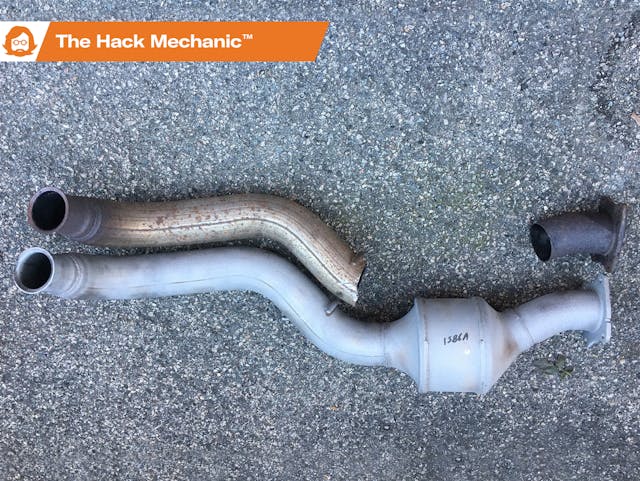
Two weeks ago, I wrote about the catalytic converter being stolen from my 2008 Chevy 3500 Duramax diesel and my decision to replace it with a correct, legal, recertified, used cat I found on eBay for $725 shipped. Then, last week I wrote about preparing for installation of the new part, which would’ve been trivial if one of the studs hadn’t snapped off the Diesel Particulate Filter (DPF) that mates with the rear of the cat assembly, requiring that I heat it taffy-soft with an oxy-acetylene torch and punch it out. Fortunately, the sawed-off front pipe was held to the motor with only a heavy-duty band clamp, so I had that off in seconds.
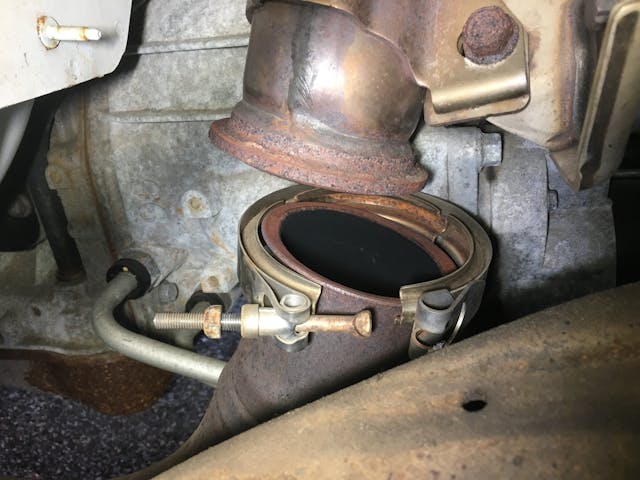
I ended last week’s piece by saying “The important thing is that, with both pieces of the cat pipe and the broken stud removed, I’m now ready to install the new cat assembly when it arrives. I’d ask, ‘How hard could it be?’ … but, well, you know.” And with the newly-purchased replacement cat assembly in front of me, and knowing that attachment was just four nuts on four studs in the back and a single clamp on the front, I thought I’d have it installed in an hour.
Oh, my word, what a colossal pain in the patootie.
The problem wasn’t so much the cat assembly’s physical size and weight, though at a full four-feet long, it certainly wasn’t dainty. The issue was alignment. The problems all stemmed from that odd front clamp.
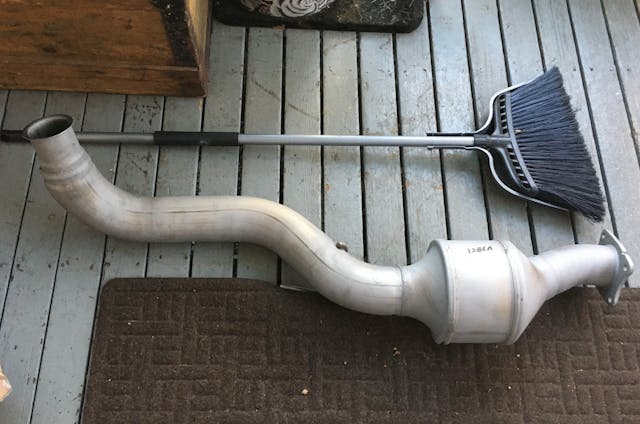
The first surprise was that there was no way to install the cat assembly without first dropping the big cross-brace that supports the massive Allison six-speed transmission and the transfer case. I didn’t need to do this when I removed the sawn-off front and rear pipes because the absence of the cat in the middle gave ample clearance to maneuver these pieces out. I’ve removed the transmission brace many times on my vintage BMWs, but on those, the brace is about the size of a ruler, whereas the sheer size and weight of this one on the truck and the load it was supporting spooked me. But a floor jack with a piece of wood beneath the transmission pan and a second block of wood under the transfer case supported it nicely, my impact wrench removed the big bolts, and out came the brace, enabling the cat assembly to be slid into place.
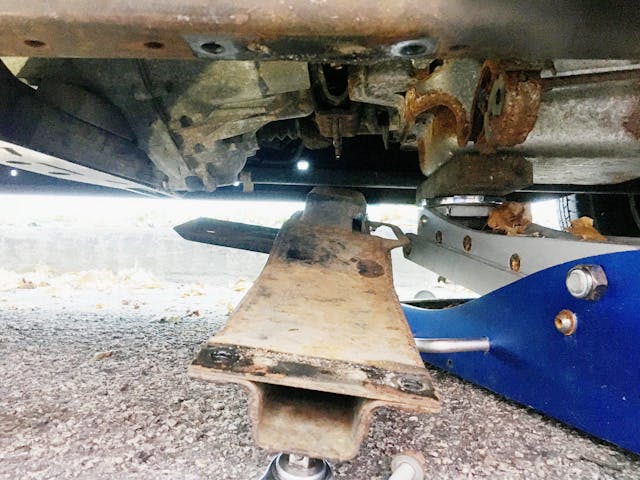
No, the total and unexpected ball-buster was the single-clamp attachment at the front of the cat pipe. The very thing that made it take just 30 seconds to remove the sawed-off front pipe also made it incredibly challenging to get the cat assembly back on.
As per the photo, the front end of the cat pipe has a flare that mates to the rounded end of the pipe that comes down from the engine. There’s no gasket or crush ring between them. They’re just held together by that weird heavy-duty band clamp. Turns out it’s called a Marman Clamp—a circular clamp with a V-shaped groove in it that, as you tighten, squeezes both halves. They’re used quite a bit in the aerospace industry, and have the very odd bit of trivia of being first produced by a company owned by one of the Marx brothers, Zeppo Marx. But there’s virtually no room for error. While they save both weight and space over a conventional flange-and-bolt arrangement, the mating surfaces have to be perfectly aligned. It’s not like the flange connecting the back of the cat to the DPF where, when you tighten the nuts on the studs, it pulls the halves toward each other. Coincidental but appropriate to the Marman clamp’s aerospace history, using it felt like docking the Space Shuttle.
Hugely complicating the alignment issue was the fact that, due to the Marman clamp, the truck’s cat assembly isn’t self-hanging. That is, on every other exhaust component I’ve ever installed, you muscle it into position, reach up, thread the nuts onto the studs or pass bolts through flange holes and spin the nuts on them, then let go and the exhaust piece hangs securely on the fasteners you just installed, allowing you to tighten everything round-robin while you check and adjust alignment. Instead, I had to support the front of this big heavy assembly with a floor jack while eyeballing the mating of the front pipes from inside the right front wheel well (having removed the fender liner), and only put on the clamp when the alignment was nearly perfect. It was a total PITA.
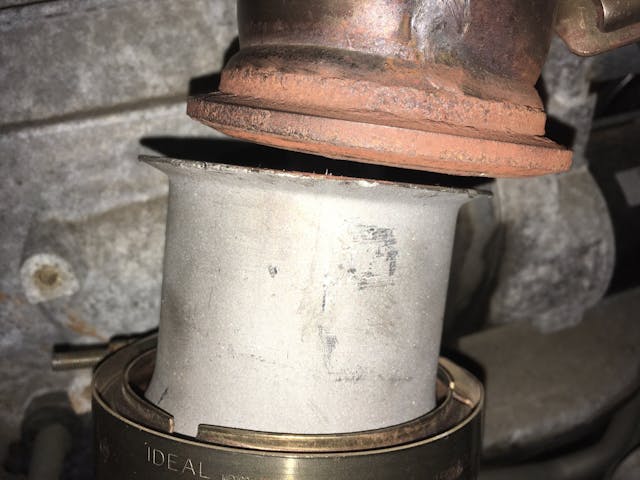
Initially, no matter what I did, I could not get the front of the cat assembly into position to line up with the pipe coming down from the engine. The assembly was free to move (that is, I hadn’t yet tightened the bolts on the flange in the back holding it to the DPF), but something was rotating the front of it off axis. I reinstalled the transmission cross-brace just in case the slight backward tip of the engine was causing the problem. It wasn’t. I disconnected the brace on the side of the transmission that held the cat assembly’s rubber hanger to add an extra degree of freedom to the movement. It didn’t help. I used two floor jacks, three ratchet straps, and several blocks of wood to coax it into alignment with the engine pipe, spending most of the day under the truck trying to get this one damned joint to line up. Nothing worked. It was maddening.
What’s more, snow was in the forecast, and I was doing this work in the driveway because the utility body on the back of the truck makes it too tall to fit in my garage. This was my window of opportunity. I wanted it completed now, but the misalignment was thwarting my every attempt.
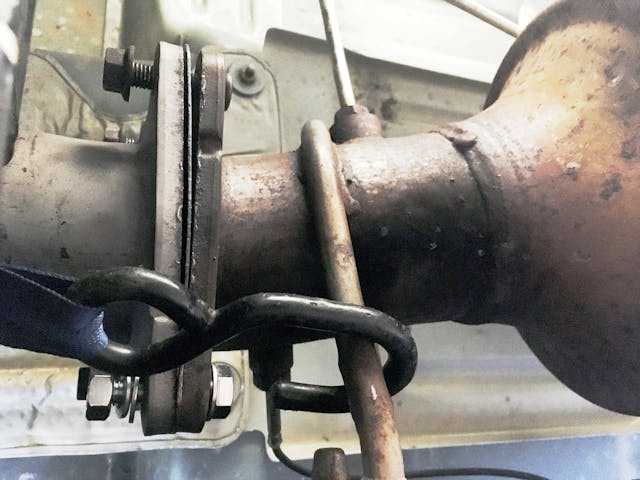
Finally, I noticed that one of the two rubber hangers was missing from the muffler in the back of the truck. This was causing the whole 15-foot-long exhaust to twist. I supported it with a hose clamp—which had the added benefit of allowing me to be able to adjust the rotation—and tried again. The alignment was much better, but I still could not get it perfect.
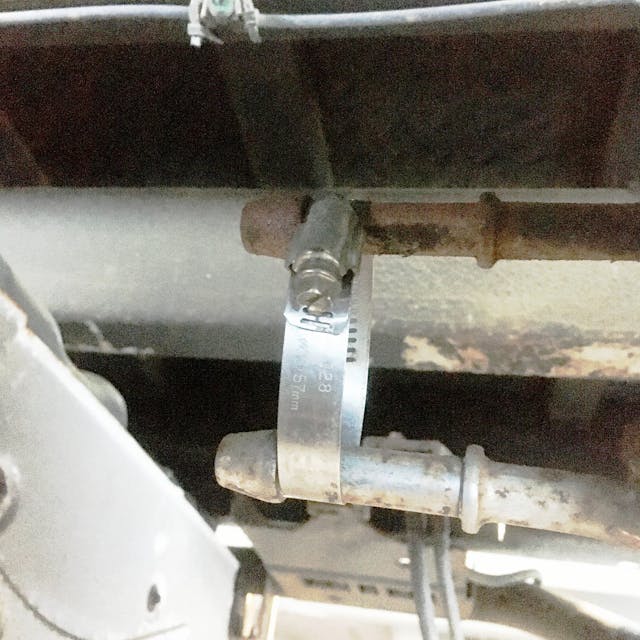
Tired, achy, and cold, I went for it, tightening the Marman clamp, hoping against hope that the groove would snug down on the flange on the cat pipe and the rounded end of the pipe coming down from the engine and seal the two tight. But I was beginning to be resigned to the likelihood that, when I was done, started the truck, and put my hand around the joint, I’d feel it leaking and might need to bring it to someone with a garage and younger back muscles and bones to finish it. However, to my surprise and joy, it was tight.
I snugged down the nuts on the studs holding the back of the cat assembly to the DPF, reinstalled the bracket with the cat’s rubber hanger in it, and torqued the bolts holding up the transmission cross-brace to spec.
I felt like I’d been run over by the truck, but I was done.
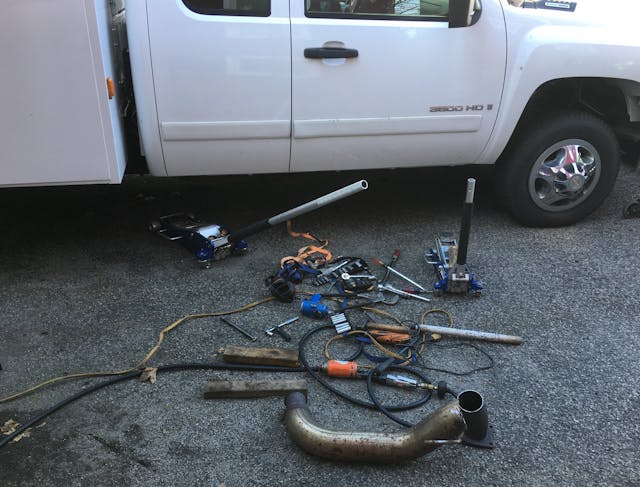
It all made me think.
I’m 64 years old, have been working on cars since my teens, and have spent 35 years writing about the sense of Zen wrenching gives me—analyzing a problem, the joy that comes from solving it your way, and saving money while doing so. Most of the work I do is either on the vintage BMWs and the Lotus Europa that I love, or on the daily-driver BMW (currently the E39 2003 530i stick sport) that I like. The vintage cars are simple, and the work on them can occur at whatever pace seems natural, as I can simply close the garage door, shut off the lights, and return to them tomorrow, the day after, or next week. The daily driver is different because it’s newer and thus much more complex, and its role is such that it needs to be kept running. Working on it is usually less Zen-like and more an exercise in driving something that I wouldn’t be able to afford if I had to pay someone to keep up with the maintenance issues. In other words, when working on the DDs, I like the result more than the process. The work I do on the Winnebago Rialta is similar; it’s a pain to work on, but I like the payoff of having the little RV to go to the beach with my wife.
In contrast, with this cat replacement, I enjoyed neither the process nor the result. There was nothing joyous about spending $800 and nearly three days because some low life chopped the cat out of my truck, a vehicle that I only own because it fell into my lap at a price I couldn’t pass up and I don’t really like or use all that much. Yes, when I was done I was glad that I had the truck back—I mean, you never know when some must-show-up-with-a-truck-and-trailer vehicle will appear on Facebook Marketplace. But so far, that’s been a hypothetical rather than an actual benefit.
As for ensuring that it doesn’t happen again, basically, you can’t. There are three main approaches: a cage around the catalytic converter, a plate blocking access to it, and an alarm system that senses the vibration of the Sawzall. The skinny on the web is that cages and plates can be cut through just like the cat pipes, and the alarm just becomes one more whoop-whoop-whoop-EEEE-YAW-EEE-YAW-whoop-whoop-whoop everyone swears at and then ignores when it goes off in the middle of the night. Cost and availability-wise, the click-and-buy online price for a cage for a truck with four-inch exhaust pipes is nearly $800, so that’s not going to happen. Regarding a plate, unlike with a high-target car like a Prius, I can’t find a click-and-buy bolt-on shield kit for this particular truck, so installing one means fabricating it, and my tolerance for doing that now that the snow’s fallen is pretty low. Amazon sells an alarm for $30, cheap enough that it’s difficult to see the downside, so I have one on order, but it’s clearly in the “better than nothing” category as opposed to a real solution.
But hey, bottom line, I got out of the stolen-cat episode for $800 and three days of wrenching. I guess I’m still going to call this one a win … as long as I soon use the truck to tow home something that I’ll actually enjoy working on.
***
Rob Siegel’s latest book, The Best of the Hack MechanicTM: 35 years of hacks, kluges, and assorted automotive mayhem, is available on Amazon. His other seven books are available here, or you can order personally inscribed copies through his website, www.robsiegel.com.


Anyone who is 60+ and has fiddled with cars since their teens has had similar experiences – where something goes beyond being a “challenge to be met” and becomes just a plain old PITA. It illustrates that there is no perfect Zen in life. Every human activity has opportunity to become FUBAR. But with time and the retelling of the stories, the pain softens and the real lessons surface. What seemed impossible and was so maddening has been overcome. Sooner or later, the scrapes on the knuckles and the strained muscles will heal. The strained mental anguish may take a little longer, but it too will relax. One doesn’t have to feel like they’ve “won” for there to be positives from such a struggle. Because deep down, our psyches know that, just like has happened since the beginning of mankind, a seemingly insurmountable obstacle has been surmounted because we didn’t give up.
You’re a better man than you were three weeks ago, Rob! 👍
DUB6, you are welcome any time for a beverage!
Interesting write up and well done. We’ve all had projects like this. In fact multiple ones. Before starting a project I always estimate how much time it should take. Then I double it. That is often a more accurate amount of time it takes me. I also keep telling myself “this is a hobby right?”
The case to sell the truck is strong.
Set aside the cost of a truck and trailer rental from the proceeds and spend the rest on your other projects. Then it still “gets that one special project home”.
And then you aren’t storing it, maintaining it, doing favors with it or worrying about people stealing parts or it.
After all, you don’t love it.
Snailfish, you’re right.
Be thankful you don’t live in California or one of the States that have a CARB compliant requirement. I needed a new catalytic converter for a 2006 SAAB 9-5. Under the new Colorado laws, I could only install an OEM item (good luck with that. Thanks, GM!) or a CARB-compliant and certified item, which nobody makes nor is going to make (“not worth the cost of certification”). After some skullduggery with my Grandson at Nellis AFB in Nevada and some re-shipping, I am now able to pass the biannual tailpipe emissions tests with numbers lower than my 2010 M-B. I am OK with the clean air visionaries, but someone needs to think through the exceptions to the norm.
You beat the cat install so be glad that you have the know how to fix it but also write cool articles. That is the “Zen”. Move on to the next project.
Rob, I have a fancy, custom stainless steel exhaust under my BMW 2002. It is in 3 sections, header, mid-section and rear section, joined with V bands. (I didn’t know they had another name, so I learned something today.) Anyway, I had a failed exhaust manifold gasket. I went to replace them and was able to unbolt the header and swing it out of the way. I figured I’d be done in 15 minutes. NOPE. Turns out the header could be removed, but not reinstalled without disconnecting it from the mid-section. OK, now it’s a 30 minute job. NOPE. I got the header back on no problem. I got the flanges to line up and the clamp in place. But I couldn’t get the t-bolt to enter into the nut to thread it. I tried everything I could, but in the end, I ended up buying a T-bolt that was 1/2″ longer (2 day Amazon shipping time included). So, 30 minutes turned into 3 days. To say I have a love-hate with V-bands is an understatement.